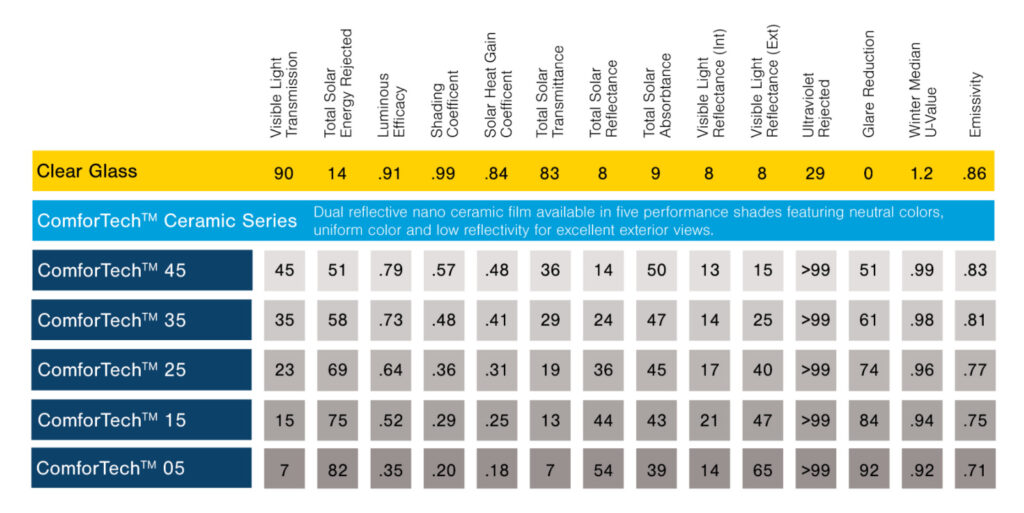
FREE SHIPPING ON PRECUT KIT ORDERS OF $100 OR MORE

Tinting your windows with residential window film provides numerous benefits, from enhanced privacy to reduced energy costs. If you’re considering a DIY window film installation for your home, it’s essential to be aware of the common window tinting mistakes to avoid that can compromise the results. In this post, we’ll explore the most prevalent pitfalls to avoid, ensuring a successful window tinting project. Let’s dive in!
Another common mistake when tinting windows is overlooking the importance of understanding the type of window film technology you are purchasing. Not all window films are made the same way. Window films come in different types, including dyed, metallic, and ceramic films. Each type offers unique characteristics and benefits:
These films use a layer of dye to reduce glare and block a certain amount of sunlight. They are generally affordable and offer moderate heat reduction. However, they may be prone to fading over time.
Metallic films incorporate tiny metal particles that provide enhanced heat rejection and glare reduction. They are more durable and effective at blocking UV rays. However, they can interfere with wireless signals and have a slightly reflective appearance.
Ceramic films use advanced nanotechnology, featuring non-metallic and non-conductive ceramic particles. They offer excellent heat rejection, UV protection, and clarity without interfering with wireless signals. They are also highly durable and resist fading.
The bottom line here is that if you don’t know what type of film you are purchasing, you won’t know what to expect in terms of quality, performance, and longevity.

Window film can provide a lot of benefits: from heat reduction, to glare control, to UV protection, to privacy. Knowing what you want to achieve and choosing the appropriate film to meet your needs is one of the first steps to a successful window film installation.
For example, if you are only interested in UV protection, it’s important to know that for most films, the amount of UV protection in a film is independent of the color/shade/darkness of the film. UV-blocking agents are most commonly included in the film’s adhesive and have nothing to do with the type of solar control material a film uses (dye, metals, ceramic).
Similarly, not all films will have the same amount of reflectivity, so not all will provide adequate daytime privacy. If you want to keep out prying eyes, it’s important to look for a film with a high solar reflectance number.
Read our post on choosing the best window film shade for the issue you want to solve.
Once you know what type of film you want to purchase, the next thing is to understand the film’s performance specifications. Not all films perform equally well!
All quality window film performance is tested and rated by the National Fenestration Rating Council (NFRC), the same organization that rates windows. Each film is measured across a set of industry-standard criteria to determine how well it will perform in the home for heat rejection, reflectivity, glare reduction, etc.

The chart above is an example of window film performance specifications for our ComforTech™ Ceramic Series film. Read more about the standard window film performance specifications and what they measure.
Based on the issue you want to solve, you should compare window films to determine which one offers the best performance for that issue. If the film you are considering does not provide this information, it is likely not rated by NFRC and you won’t know how the film will actually perform on your windows.
Using the right tools can significantly simplify the window film installation process and enhance the overall outcome. Some essential tools include a razor blade scraper, utility knife, squeegee, spray bottle with a solution (water and a few drops of Slip-tack or dish soap), and paper towels. Investing in these tools will make the installation smoother and help eliminate potential mistakes.
Using old, used, or dirty tools can impact the quality of your window film installation. For example, using a spray bottle that had another chemical or cleaner in it runs the risk of some of that residual chemical getting onto your film. This could affect the integrity of the adhesive leading to adhesion issues.
While window film is relatively robust, and our film is treated with a hard coat to prevent scratches, there is always a chance that you scratch or mar the film. Using an old, brittle rubber squeegee or one with a chip or flaw in it can scratch the film during the installation process.
When making an investment in window film, it’s best to purchase professional tools the pros use to ensure a great installation.
As with most DIY projects, good preparation is key to the success of the endeavor. One of the most critical steps in window film installation is preparing the glass surface properly.
Before applying the film, make sure to clean the glass using a mild detergent and lint-free cloth. We also recommend using a razor blade scraper to remove any adhesives or glue or small debris particles that might be stuck to the window. It’s also a good idea to clean the outside of the windows as well so that you can see if the window is free from dirt and is ready for film.

Failing to clean the windows thoroughly can lead to adhesion issues, dirt being trapped under the film, and a subpar finish. Read more on our post about window film preparation tips.
Accurate measurements are vital to ensure that the window film fits correctly and covers the entire glass surface. We recommend including at least ½” to 1” of extra film around all edges of the window for ease of installation.
A common mistake is underestimating the dimensions or assuming all windows are the same size. Take precise measurements of each window, accounting for any architectural features, such as curves or angles. Keep in mind that a lot of older windows are not perfectly square, so you can’t assume that.
Measuring each window and including appropriate overage will avoid wasting film and achieve a seamless appearance.
For a seamless and professional-looking DIY window film installation, consider using Concord Window Film.
Our mission is to provide the same professional-grade window film available to installers, to DIY homeowners like you to improve your home’s comfort and efficiency. We looked at what is available on the market for DIYers and knew we could do better. Our ComforTech™ Ceramic Series film is superior with its dry adhesive and thicker size – two things that make installation much easier.
From excellent heat control to enhanced privacy to UV protection, Concord Window Film offers reliable products that deliver exceptional results. Shop ComforTech™ Ceramic Series films.
By being aware of the common mistakes to avoid when tinting your windows, including understanding window film technology and performance specifications, you can achieve a successful DIY residential window film installation. Remember to prioritize proper surface preparation, take accurate measurements, utilize the right tools, and apply the film with patience and care. By following these guidelines and considering Concord Window Film as your trusted choice, you’ll enjoy the benefits of professionally tinted windows in your home.
Remember, a successful window tinting project is within your reach. Happy tinting!